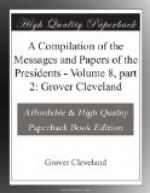The Constitution declares that the judicial powers of the United States extend to cases arising under the laws of the United States, and that such laws, the Constitution, and treaties shall be paramount to the State constitutions and laws. The judiciary act prescribes the mode by which the case may be brought before a court of the United States by appeal when a State tribunal shall decide against this provision of the Constitution. The ordinance declares there shall be no appeal—makes the State law paramount to the Constitution and laws of the United States, forces judges and jurors to swear that they will disregard their provisions, and even makes it penal in a suitor to attempt relief by appeal. It further declares that it shall not be lawful for the authorities of the United States or of that State to enforce the payment of duties imposed by the revenue laws within its limits.
Here is a law of the United States, not even pretended to be unconstitutional, repealed by the authority of a small majority of the voters of a single State. Here is a provision of the Constitution which is solemnly abrogated by the same authority.
On such expositions and reasonings the ordinance grounds not only an assertion of the right to annul the laws of which it complains, but to enforce it by a threat of seceding from the Union if any attempt is made to execute them.
This right to secede is deduced from the nature of the Constitution, which, they say, is a compact between sovereign States who have preserved their whole sovereignty and therefore are subject to no superior; that because they made the compact they can break it when in their opinion it has been departed from by the other States. Fallacious as this course of reasoning is, it enlists State pride and finds advocates in the honest prejudices of those who have not studied the nature of our Government sufficiently to see the radical error on which it rests.
The people of the United States formed the Constitution, acting through the State legislatures in making the compact, to meet and discuss its provisions, and acting in separate conventions when they ratified those provisions; but the terms used in its construction show it to be a Government in which the people of all the States, collectively, are represented. We are one people in the choice of President and Vice-President. Here the States have no other agency than to direct the mode in which the votes shall be given. The candidates having the majority of all the votes are chosen. The electors of a majority of States may have given their votes for one candidate, and yet another may be chosen. The people, then, and not the States, are represented in the executive branch.




